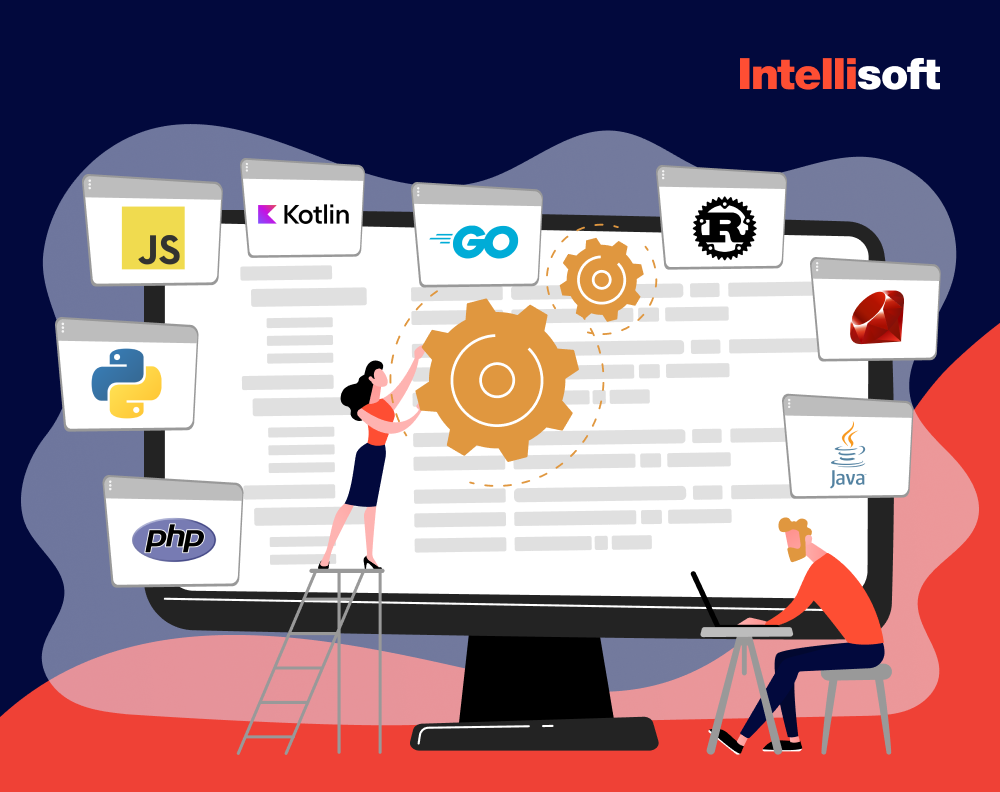Picture yourself at the helm of an innovative new product, racing to get features and updates to market faster than your competition. But how do you ensure every team member is rowing in the same direction? That’s where a product roadmap comes in.
At IntelliSoft, we help clients achieve their goals with tailor-made roadmaps that guide them through challenges like prioritization, stakeholder alignment, and rapid iteration. In this product roadmap guide, you will learn how a clear, strategic roadmap can empower your team to deliver exceptional results.
Imagine a typical scenario for a startup: they decide to work on their first mobile app project ever to impress potential customers. An application may require a lot of resources to develop. If you want to see a return on your investment, you need to put in a lot of time cultivating new leads and clients at the outset.
That is when a significant obstacle pops up. Managers and the marketing department can’t make presentations without a working version of the product.
So how do you maintain a healthy work pace and avoid getting lost in the project woods? How do you successfully get from point A (idea) to point B (launch)? Very simple – with the help of a template for product roadmap. At least, that is how we at IntelliSoft see it and recommend it to our clients.
We used to help with a product roadmap and followed this document strictly when working with GrowthWheel. To achieve the goal of launching the working MVP, this US consulting company has hired our experts to rescue the project. We still cooperate with this client and carry out new projects together, and good product roadmaps are one of their keys to success.
So, it is about time to find out what a product roadmap is, how to create a product roadmap, where it can take you and your shareholders, how important a product plan is, and what tools can assist you with crafting this document.
Table of Contents
What Is Product Roadmapping?
A product roadmap is a visual representation of the steps to realize the product’s long-term goals. It is different from a technology roadmap by its purposes and essence. Different teams of specialists or departments can coordinate their efforts more easily on individual project tasks with the help of this program. Simply put, the roadmap facilitates teamwork in any project, no matter how intricate. It is vital that you adapt this document to any changes in customer behavior or new market trends. You can see a product roadmap example below.

What distinguishes a product road map from a business plan or marketing strategy? At the outset of a project, a roadmap is developed to foresee how a competitive development strategy will look. It can also be created after the project launch if there are dramatic changes in operations in the process.
The timeframes included in roadmap plans typically span three months to a full year. The maps contain information like reporting requirements, milestone due dates, and top priorities. In this way, a product roadmap stands apart from a standard marketing plan (MP). MP is a detailed description of each stage of the work with clear requirements for every participant.
Who Are Roadmaps for?
There are several ways to classify product roadmaps. One of them is by purpose. Decide for whom and why you need to create a product management roadmap template.
- Internal roadmap for executives (e.g., CEOs)
These roadmaps emphasize how teams’ activity contributes to achieving company-wide goals and benchmarks. They are frequently grouped by month or quarter to demonstrate progress towards these objectives over time, and typically contain less information regarding detailed development stories and tasks.
“I personally prefer outcome-driven/problem-driven product roadmaps because they emphasize the desired outcomes without prescribing solutions in six months, a classic antipattern that impedes product innovation.” Kosta Mitrofanskiy – CEO @ IntelliSoft A technology expert and entrepreneur with 20+ years of experience in the web & software development business. - Internal roadmap for engineers/developers
Engineering roadmaps are typically technology roadmaps used to plan out key efforts, such as the migration of various software systems or the compliance work required to comply with a new rule. A chief technology officer and other tech staff are responsible for them. These technology roadmaps may also be shared with vendors and partners who rely on, for instance, integrations. - Internal roadmap for sales
This map should consider how the product will directly help sales representatives, as well as the user benefits they may promote to clients and prospects. It groups comparable features/items into themes that sales representatives can discuss with prospects whenever possible. - External roadmap for users
Why should a customer buy this product? The value to the customer must be made crystal obvious. Also, do not forget to specify the release dates in an external roadmap for clients (only if you are 100% sure about them).
Types of Product Roadmaps
Several types of product roadmaps are known. They are basically related to the business goals. Decide which one is right for you based on these brief descriptions.

- The Project Roadmap. This is a helpful tool for product managers. It can be used to facilitate communication between groups working on separate projects. Specialists can grasp the big picture and how their work fits into it.
- The Evolutionary Roadmap. For instance, your group works without a clear idea of how the project should turn out. The best guess is probably all you can do at this point. Just use this method of communication to share updates with everyone.
- The Market Requirements Roadmap. This map is mostly concerned with market placement. This is how you position and present your solution like a mobile app.
- The Release Roadmap. The release plan details your product’s upcoming updates, additions, and bug fixes. Typically, a release plan will cover three to six months, though shorter sprints may also be used.
- The Capacity Roadmap. This is tied to a release roadmap. What will be generated is outlined to facilitate teamwork and collaboration.
- The Theme Roadmap. A theme-based roadmap specifies the product’s topics or objectives within a particular time frame. Themes or objectives are derived from the market problems you intend to answer. The topics inform your stakeholders of which problems will be addressed and within what period.
- The Timeboxed Roadmap. This tool is similar to the product release roadmap. One key distinction is that it provides more details and specifics. Despite the apparent implication of the title, dates are not supplied.
- The Opportunity Roadmap. Use this road map if you run a business that sells to other businesses (B2B). Its primary goal is to encourage commercial expansion.
Purposes of a Product Roadmap
Several good reasons exist why startups create product roadmaps and stick to them.
- Formation of a shared goal. To put it simply, a roadmap is a set of guidelines that can be accessed by anyone working on a project at any time.
- Key issues discussed easily. To keep everyone on the same page, you should have a roadmap for product development with your planned milestones and objectives. Anybody can view them, allowing for swift adjustments to ongoing projects as new information or insights become available.
- Increased efficiency of conversation. A roadmap facilitates communication and collaboration between process stakeholders such as management, individual departments, and team members.
- Work reconciliation. To bring harmony to the workplace. It’s much simpler to keep everyone on the same page as work progresses, thanks to the roadmap.
Who Is Responsible for the Product Roadmap?
Given the duration of this tool’s use, a senior expert should put the plan into action. This role can be filled by a product manager, project manager, or business manager. They are accountable for coordinating efforts among teams and ensuring that deadlines are met, at least roughly. To be more specific, these professionals should address:
- Verification entails checking up on how well plans are working.
- Steps and benchmarks to be achieved and an outline of the first steps are all part of the implementation phase.
- Strategic forethought and objective setting are the essence of planning.
- Doing something about it: auditing, adjusting, and reshaping the standard.
Why can deadlines shift? Mainly because the roadmap doesn’t provide a “how” solution. Therefore, it is challenging to foresee what challenges or, alternatively, beneficial possibilities would come during implementation when setting a goal at the outset of project development. It is the project manager’s responsibility to evaluate the shifting circumstances and make prompt changes to the roadmap.
Why Do We Need a Roadmap?
Communicating the main ideas and keeping an eye on the task progress are two primary usages of a product roadmap. Shareholders, customers, and partners should all be able to see this doc and offer necessary changes.
A roadmap for product development consists of a global-level initiative and all of its stages. There is no need to list every product function and describe it in detail. Specialists should rather use this strategic doc for separate planning. While the market is highly dynamic because of the regular changes in user preferences and other factors, updating the roadmap is a must. Top management, sales, support, stakeholders, partners, clients, engineers, financial specialists, and product staff should be involved in activities specified in a product map.
What to include in this document depends on the specific audience. We have discussed it above. In general, startups need product roadmaps as:
- They show where the team should go to achieve its goals.
- They ensure all teams are on the same page.
- They help to set priorities.
- They allow for objective feedback.
- They look at all fields of the product journey to detect and eliminate gaps.
Differences Between Roadmaps in Agile And Waterfall
The two main types of roadmaps are the cascading type (waterfall) and the agile one. The first is less frequently applied because it’s based on an antiquated planning paradigm. The waterfall roadmap depicts a series of events over a very long time horizon, beginning with a few years, which is the only notable difference between the two. In comparison, the agile roadmap illustrates how work is finished over a few months to a few quarters.

Accordingly, building a waterfall roadmap is quite simple. The manager sets the maximum timeline for project or business development and then determines a separate pool of tasks and deadlines for each team. Afterward, the project is redirected for further implementation by other specialists.
Related readings:
- Story Point to Hours: Which Estimation Approach to Choose?
- Making Sense of Databases: How to Choose the Right One
- From Concept to Creation: How to Master the Discovery Phase of Product Development
- User Story Acceptance Criteria Explained with Examples
- Product Requirements Document (PRD) – Why Make It Lean?
Benefits & Challenges of Creating a Project Roadmap
Developing a product roadmap for business is a must for many start-ups and big corporations. This tool, no doubt, provides plenty of advantages. Still, some challenges are associated with it.
Benefits
Product roadmaps’ key advantage is that they ensure short-term product goals are achieved as quickly as feasible while monitoring and changing the company’s long-term objectives. Let’s look at each primary benefit closer.
Provides shareholders with how the development process takes place
Product roadmaps narrow down the competing priorities to what is most crucial. They also transform developer tasks, such as those in Jira, into plain-language phrases and a structure simple for corporate leadership to understand.
The specifics of how you’ll carry out those assignments start to emerge once your vision and strategic goals have been visually set out. Business and product priorities will align as you showcase the work that matters most to key stakeholders, allowing you to concentrate on things that are more significant than others. It leads to better decision-making.
Assists with controlling/prioritizing the backlog
It’s good when just one team can handle the product backlog and roadmapping. Its members should define how the product is anticipated to develop throughout multiple major releases. As a result, the backlog can now concentrate on tactical work, such as implementing epics and user stories necessary to produce one or more releases.
Pretend you develop a new product version every 3-4 months. Add several upcoming releases to a product roadmap as the backlog focuses on generating the following version.
Aligns the business around common product goals
Product roadmaps make it possible for all members to focus on the same targets. Together, these experts agree on what matters the most instead of wasting time on less critical things first.
An excellent roadmap clarifies the meaning of each contribution. It fosters shared ownership of the product’s success and serves as an inspiration.
A product roadmap encourages and supports cross-functional cooperation. By outlining who will be responsible for what tasks and identifying potential dependencies and opportunities across departments, it assists teams in aligning on execution.
Makes end users more satisfied
Roadmaps bring together teams working on high-impact product improvements for product owners and managers. These docs may show how relevant a feature is in the process of development.
Public product roadmaps are a communication strategy that encourages customer base unity and enthusiasm. They signal to the rest of the industry that you intend to do more than simply improve and alter the current capabilities.
Users and potential clients could gain from getting a sneak peek at what’s coming up and where their particular requests fit/don’t fit on your roadmap.
Challenges
Even though some difficulties associated with product road mapping exist, keep in mind that there are always ways to overcome them.
Prioritize functionality, not users
A feature is required by marketing for a campaign. For a new customer, the sales team needs to address a problem. PayPal integration is desired. You see what I mean.
When stakeholders’ priorities change from what customers value to what they believe would make the product more desirable, this creates a problem. A prioritized list of features is essentially what the product plan turns into.
What is the solution? Concentrate on work themes. Teams can tell a story about where they’re going and the goals, objectives, and outcomes that will bring them there by categorizing their work into themes. Also, pay attention to feedback from your clients. Direct customer insights make using data to prioritize the product backlog much simpler than depending on intuition.
Stifle innovation at the team level
It’s simple to get into the habit of developing an internal roadmap that is just concerned with new features and their release dates. After all, that typically ensures stakeholder comfort.
The team loses autonomy as a result, though. They cannot solve issues by coming up with novel solutions that go beyond those that have already been established. Additionally, in a dynamic corporate environment that demands more flexibility, time-based roadmaps might occasionally be too limiting.
What is the solution? First, your roadmap should focus on the overall picture and challenges to solve rather than the answers to those problems, regardless of your development roadmap style. Second, a real plan is always open to change. Product roadmaps exist to assist with your product strategy. When your organization shifts its emphasis or course, it’s acceptable to alter—or even stop using—your current product plan.
Provides a false sense of confidence
It cannot deliver a completely accurate picture of the future. Product roadmaps offer a picture of where the product could go and demonstrate current opinions on product strategy and prioritization. However, the outcomes are not guaranteed in case of any force majeure.
Product roadmaps inform stakeholders of the product’s direction. At the same time, they must be mindful that as the competitive landscape changes, customer tastes and anticipated features also change.
Otherwise, this false sense of confidence can lead to poor prioritization in roadmaps, leading to problems, notably with resource allocation.
What is the solution? Don’t design your products based on projections about the future; instead, design them to adapt to changes as they occur. Accept that change is unavoidable and construct your product roadmap and processes on that assumption. Regularly review the doc and update it only if needed. In addition, instead of making early commitments to deliver on specific dates, request more time in product discovery to study the appropriate solution.
Popular Methods for Product Roadmap Prioritizing
RICE is a grading system that helps you prioritize and consider each aspect of a project you’re working on. RICE is an abbreviation for Reach, Impact, Confidence, and Effort. The following elements must be considered when determining the priority level:
- Reach. Examines the number of people or events that will impact each project over a specific period.
- Impact. Describes how each feature contributes to the overall product.
- Confidence. Is calculated on a percentage scale, quantifying the influence.
- Effort. Determines how much team strength is required to focus on a feature quickly and efficiently to contribute to its impact.

The advantages of this strategy include being more educated in making decisions as a project manager and knowing what to do first to have the most significant impact. However, this method is time-consuming, and there isn’t usually much data for each product.
If money talks on your team—and let’s be honest, money talks on every team—a cost of delay (CoD) analysis is a useful prioritizing approach. The CoD approach calculates how much potential revenue is lost when a product or endeavor is not worked on. To use the cost of delay for product prioritization, you’ll need to add a time limit to compare several projects, resulting in the cost of delay by duration, or CD3.
CoD is a great method as it makes it possible to compare projects based on a single variable: revenue. It also allows one to earn buy-in when revenue is a core company initiative. Still, keep in mind that a product effort must be able to generate income. CoD won’t assist if you only have a few comparably profitable and time-consuming tasks.
How to Create a Product Roadmap: Tools for Crafting a Project Roadmap
You should not do everything manually, as many instruments for developing a product roadmap exist. Consider the most popular tools and free/paid services.
Spreadsheets
One of the easiest ways to create a roadmap is to use spreadsheets. For example, you can use Excel to compile product ideas and set deadlines and timelines. It’s easy enough to update them.
However, roadmaps in e-tables have significant disadvantages. The tables do not have sufficient visualization and are insufficient to represent the strategic plan. In addition, Excel and most of its analogies are static documents, which are difficult to control and synchronize their versions with all members of the team.
Presentations
It is much easier to visualize the roadmap as a presentation file. Here, the product manager has more options and freedom of action.
However, even in this case, the presentation is a static doc that requires manual updates, just like a spreadsheet, which can lead to confusion with version control. Ideally, the roadmap should be updated synchronously by all team members. That’s why a product management service with roadmap functionality is becoming increasingly popular today.
Special Services & Apps
Product managers today have the ability to visualize roadmaps with the best management tools to help:
- Present the roadmap for product development visually
- Link global strategy to roadmap processes
- Identify and evaluate ideas
- Collaborate with all stakeholders (including customers and non-tech colleagues)
- Integrate with third-party systems
The question is which service to choose. We would describe some of them.
- Roadmunk: A product roadmap tool with a visual roadmap.
- ProductBoard: A product management system that assists teams in creating goods that customers want.
- Jira: A flexible and scalable issue-tracking system for software development teams.
- Aha!: A strategic planning and product roadmap software tool for agile product managers on the web.
- ProdPad: A tool for roadmap planning that allows you to collect ideas and input, generate product specifications, and create a product roadmap.
- ProductPlan: This tool allows you to plan and share your product roadmap.
If you don’t want to try something new for a product roadmap development, you may always turn to good old Google Sheets. It’s a simple tool for entrepreneurs to collaborate swiftly on feature ideas.
Agile Product Roadmap Template Creation
Creating an agile product roadmap template requires strategic planning to ensure successful development. A product development roadmap template can simplify this process by helping you visualize goals, align teams, and identify key milestones. Here’s how you can effectively structure a roadmap:
Understanding Templates
Your product development roadmap template can vary depending on the organization and purpose but generally provide frameworks for timelines, goals, and progress. Choosing the right software product roadmap template helps ensure your roadmap matches your business model and appeals to your internal or external audience.
Types of Roadmap Templates
Time-Based Roadmap
- Quarterly: Great for setting deliverables over three-month periods, offering detail for short-term planning while keeping it adaptable.
- Monthly: Ideal for short-term goals and agile sprint teams.
Feature-Based Roadmap
- Release Plan: Emphasizes product releases and features, clearly outlining what’s coming in each version.
- Feature Prioritization: Shows how features are prioritized, fostering cross-team understanding of priorities.
Goals-Oriented Roadmap
- Objectives & Key Results (OKR): Focuses on broad goals, linking them to features and visualizing how tasks contribute to overall objectives.
Customer Journey Roadmap
- Persona-Centric: Illustrates how different customer personas interact with the product, useful for tailoring features to user needs.
Building a Software Product Roadmap Template
Define Goals
Identify your roadmap’s strategic goals and ensure they align with broader business objectives. For example, you can create a product launch roadmap template with specific goals in mind
Choose a Timeframe
Based on your product and development approach, determine whether the roadmap will cover quarterly, monthly, or other periods.
List Features & Milestones
Identify key features and milestones and organize them logically on the roadmap.
Assign Responsibilities
Ensure each feature or milestone has an accountable owner. Include internal stakeholders as needed.
Regular Reviews & Iterations
Schedule regular reviews to adapt the roadmap to market changes and feedback.
Benefits of Templates
Alignment
Unifies stakeholders around a shared vision, reducing friction in prioritization.
Flexibility
Offers a framework that can adapt to changing business needs.
Transparency
Improves communication and collaboration by making progress visible.
Predictability
Helps forecast timelines, manage resources efficiently, and foresee challenges early.
Choosing the Right Template
Business Model Compatibility
Choose a simple product roadmap template that suits your business model and development style, whether you’re in frequent sprints or longer cycles.
Team Size & Structure
Ensure the roadmap matches your team’s scale and skill set.
Audience Needs
If presenting to external stakeholders, prioritize clarity and simplicity.
Product roadmap templates are valuable tools for visualizing progress and maintaining alignment. Selecting the right framework and customizing it to your goals creates a unified vision for your product’s journey. Regular reviews keep the roadmap relevant in a changing market. A simple product roadmap template can empower product managers to communicate effectively, adapt quickly, and deliver outstanding products.
Stages of Creating Roadmap
The process of a product roadmap development might take some time as several stages are included, and all of them are equally important.

Target audience wisely
At this stage, you need to understand for whom the roadmap will be intended. Would you like to impress stakeholders or investors? Probably, you are about to create one for the end user. You may also choose tools for roadmapping at the initial stage.
Define your strategy
Select a structure based on the target audience. There is a conventional division into three types of roadmaps: with a timeframe, without a timeframe, and a hybrid type. Timelines help you understand the approximate timeline for each stage. Without clear timeframes for long-term planning, a roadmap without timelines is used. The hybrid type of roadmap is suitable for short-term planning. Also, formulate ideas, key goals, and tasks. You may avoid going into details.
Customize release
This is when you select the features to highlight and decide whether internal or external data should be present in each release. Dates of external and internal releases may be different.
Prioritize features
Remember that you should always look at customer requests in light of your strategy. There are many ways to measure how well your strategy is working. Since every product is different, making your scorecard is easy. With your scorecard in place, you can reasonably rank your roadmaps. Remember the general rules for setting priorities and the well-known ways to set priorities.
Share the roadmap
Great things cannot be produced without communication, feedback, and relationship transparency. When you achieve the desired outcome, you can store and distribute it to your stakeholders. With software containing a product management roadmap template, you can quickly share and maintain your roadmaps.
Decide on the ways to control
The roadmap should record the current results of the work so that there is always an opportunity to adjust further tasks or ensure that everything is going according to plan. Therefore, thoughtful quality control is necessary.
Use and update your roadmap
The roadmap should be updated as necessary, perhaps weekly or biweekly so that it stays an accurate source. If a roadmap is not up-to-date, it is useless. If your roadmap must be updated more frequently, your stakeholders will call you for updates instead of examining your map. These one-time requests demonstrate a lack of confidence in your product roadmap and a huge potential time drain. Nevertheless, do not waste time making unneeded modifications.
Summing Up
Road maps seem like necessary and valuable management tools. They help manage team schedules, hold discussions, break tasks down into smaller tasks, get work done on time, measure performance, and obtain good results.
A road map is needed to show the end goal and how to get there. The roadmap shows all the key stages and deadlines, which helps to coordinate the work between the company departments and individual employees. DevOps engineers, product managers, marketing specialists, and other specialists use roadmaps in their work.
A powerful strategic tool in product management is well-made software with a roadmap option. We at IntelliSoft know it for sure. If you turn to us, we can do more than create a product roadmap for you – we can even build up your project from scratch. Do not hesitate to contact us if you have any questions.










